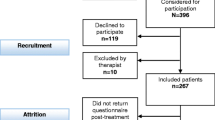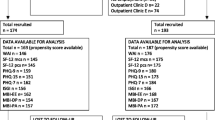Abstract
This article contrasts trends in addressing work productivity in severe mental illnesses (SMI) such as schizophrenia and in affective disorders. Citations from searches of 8 reference databases were reviewed.
The negative impact of SMI on employment is indisputable, as is the fact that people with these disorders could be employed more frequently than is the case. For those with SMI, work rehabilitation treatment models have been developed, but their implementation in disease management programs has lagged behind those of other diseases. In contrast to the situation with SMI, treatment outcomes in affective and anxiety disorders have been defined primarily in terms of symptom relief and interpersonal functioning. Attention to work productivity has emerged more recently as employers have become important stakeholders in healthcare decision making. Since most patients with affective disorders are already in the work force, some work productivity initiatives and outcomes developed for SMI may not be appropriate for patients with affective disorders. Attention to work productivity has not been systematically incorporated into treatment planning for affective disorders, and specific work-related psychiatric interventions are not yet available.
In conclusion, the cost effectiveness of work productivity interventions in psychiatry requires their integration into comprehensive disease management programs. In making resource allocation decisions, appropriate incorporation of work productivity within a larger ethical framework of healthcare decision making is essential. The furtherance of work productivity initiatives in psychiatry requires collaboration among numerous stakeholders in professional education, service delivery and research.




Similar content being viewed by others
References
Crowther R, Bond G, Huxley P, et al. Vocational rehabilitation for people with severe mental disorders (protocol for a Cochrane review). In: The Cochrane Library. Oxford: Update Software, 2000; (3)
Kirschstein RL. Insurance parity for mental health: cost, access and quality. Final report to Congress by the National Advisory Mental Health Council. Washington, DC: National Institute of Mental Health, 2000 [online]. Available from: URL: http://www.nimh.nih.gov/parity/paritytoc.cfm [Accessed 2000 Nov 29]
England MJ. The TEN interview. TEN (The Economics of Neuroscience) 2000; 2(6): 32–4
Kessler RC, Frank RG. The impact of psychiatric disorders on work loss days. Psychol Med 1997; 27: 861–73
Healthy people 2010. Volume 2 [online]. 2nd ed. Available from: URL: http://www.health.gov/healthypeople/Document/tableofcontents.htm#Volume2 [Accessed 2000 Dec 17]
Cook JA, Razzano L. Vocational rehabilitation for persons with schizophrenia: recent research and implications for practice. Schizophr Bull 2000; 26: 87–103
Lehman AF. Developing an outcomes-oriented approach for the treatment of schizophrenia. J Clin Psychiatry 1999; 60 Suppl. 19P: S30–5
Kupper Z, Hoffmann H. Course patterns of psychosocial functioning in schizophrenia patients attending a vocational rehabilitation program. Schizophr Bull 2000; 26: 681–98
Castle D, Sham P, Murray R. Differences in distribution of ages of onset in males and females with schizophrenia. Schizophr Res 1998; 33: 179–83
Haas GL, Garratt LS, Sweeney JA. Delay to first antipsychotic medication in schizophrenia: impact on symptomatology and clinical course of illness. J Psychiatr Res 1998; 32: 151–9
Gold JM. Work outcome in schizophrenia- brain function/structure. US National Institutes of Mental Health Grant #5RO1MH57749-03. Available from: URL: http://crisp.cit.nih.gov [Accessed 2001 Aug 31]
Lehman A, Steinwachs D. Patterns of usual care for schizophrenia: initial results form the Schizophrenia Patient Outcomes Research Team (PORT) survey. Schizophr Bull 1998; 24: 11–20
Mohtabai R, Nicholson RA, Carpenter BN. Role of psychosocial treatments in management of schizophrenia: a metaanalytic review of controlled outcome studies. Schizophr Bull 1998; 24: 569–87
Becker RE, Meisler N, Stormer G, et al. Employment outcomes for clients with severe mental illness in a PACT model replication. Psychiatr Serv 1999; 50: 104–6
Drake RE, Becker DR, Clark RE, et al. Research on the Individual Placement and Support model of supported employment. Psychiatr Q 1999; 70: 289–301
Bell MD, Lysaker PH. Clinical benefits of paid work activity in schizophrenia: 1-year followup. Schizophr Bull 1997; 23: 317–28
Hser YI, Anglin MD, Grella C, et al. Drug treatment careers. A conceptual framework and existing research findings. J Subst Abuse Treat 1997; 14: 543–58
Lehman AF. Public health policy, community services and outcomes for patients with schizophrenia. Psychiatr Clin North Am 1998; 21: 221–31
Ridgway P, Rapp C. Active ingredients in achieving competitive employment outcomes for people with psychiatric disabilities: a research synthesis. National Technical Assistance Center for State Mental Health Planning. Lawrence (KS): University of Kansas School of Social Welfare, 1998
Braitman A, Counts P, Davenport R, et al. Comparison of barriers to employment for unemployed and employed clients in a case management program: an exploratory study. Psych Rehab J 1995; 19(1): 3–8
Bybee D, Mowbray C, McCrohan N. Toward zero exclusion in vocational opportunities for persons with psychiatric disabilities: prediction of service receipt in a hybrid vocational/case management approach. Psych Rehab J 1996; 19(4): 15–27
Trotter S, Minkoff K, Harrison K, et al. Supported work: an innovative approach to the vocational rehabilitation of persons who are psychiatrically disabled. Rehab Psychol 1988; 33(1): 27–36
Bond G, Haines M. The Hartford study of supported employment. Presentation at the Illinois Association of Psychosocial Rehabilitation State Conference; 2000 Nov 17. Matterson (IL)
Wallace CJ. Clinical trial of the Workplace Fundamentals Module. US National Institutes of Mental Health Grant #5RO1MH57029-02. Available from: URL: http://crisp.cit.nih.gov [Accessed 2001 Aug 31]
Bond GR. Comparison of two employment models for clients with SMI [online]. US National Institutes of Mental Health Grant #5RO1MH59987-02. Available from: CRISP database: URL: http://crisp.cit.nih.gov [Accessed 2001 Aug 31]
Cook JA. The employment intervention demonstration program [online]. Available from: URL: http://freud.psych.uic.edu/eidp/ [Accessed 2000 Dec 17]
Landis JB. Estimating net effects and costs of service options for persons with serious mental illness. Psychiatr Serv 1999; 50: 735–8
Newman MG. Recommendations for a cost-offset model of psychotherapy allocation using generalized anxiety disorder as an example. J Consult Clin Psychol 2000; 68: 549–55
Melle I, Friis S, Hauff E, et al. Social functioning of patients with schizophrenia in high-income welfare societies. Psychiatr Serv 2000; 51: 223–8
Priebe S, Warner R, Hubschmid T, et al. Employment, attitudes toward work, and quality of life among people with schizophrenia in three countries. Schizophr Bull 1998; 24: 469–77
Noble JH. Policy reform dilemmas in promoting employment of persons with severe mental disorders. Psychiatr Serv 1998; 49: 775–81
Ticket to Work and Work Incentives Improvement Act of 1999 [online]. Available from: URL: http://hcfa.hhs.gov/medic-aid/twwiia/twwiiahp.htm [Accessed 2000 Dec 12]
The World Health Report. Geneva: World Health Organization, 1999
Russell JM, Patterson J, Baker AM. Depression in the workplace: epidemiology, economics and effects of treatment. Dis Manage Health Outcomes 1998 Sep; 4(3): 135–42
Rice DP, Miller LS. Health economics and cost implications of anxiety and other mental disorders in the United States. Br J Psychiatry 1998; Suppl 34: 4–9
Kessler RC, Barber C, Birnbaum HG, et al. Depression in the workplace: effects on short term disability. Health Aff 1999; 18(5): 163–71
Dewa CS, Lin E. Chronic physical illness, psychiatric disorder and disability in the workplace. Soc Sci Med 2000; 51: 41–50
Birnbaum HG, Cremieux PY, Greenberg PE, et al. Management of major depression in the workplace: impact on employee work loss. Dis Manage Health Outcomes 2000; 7(3): 163–71
Berndt ER, Bailit HL, Keller MB, et al. Health care use and at-work productivity among employees with mental disorders. Health Affairs 2000; 19(4): 244–56
Druss BG, Rosenheck RA, Sledge WH. Health and disability costs of depressive illness in a major US corporation. Am J Psychiatry 2000; 157: 1274–8
Mintz J, Mintz I, Arruda MJ, et al. Treatments of depression and the functional capacity to work. Arch Gen Psychiatry 1992; 49: 761–8
Simon GE, Revicki D, Heiligenstein J, et al. Recovery from depression, work productivity and health care costs among primary care patients. Gen Hosp Psychiatry 2000; 22: 153–62
Oyster CK, Hanten WP, Llorens LA. Introduction to research. A guide for the health science professional. Philadelphia (PA): J. B. Lippincott, 1987: 131
Reilly MC, Zbrozek AS, Dukes EM. The validity and reproducibility of a work productivity and impairment instrument. Pharmacoeconomics 1993; 4: 353–65
Chirban JT, Jacobs RJ, Warren J, et al. The 36-item Short Form Health Survey (SF-36) and Work Productivity and Impairment (WPAI) Questionnaire in panic disorder. Dis Manage Health Outcomes 1997 Mar; 1(3): 154–64
Lambert MJ, Burlingame GM. Outcomes Questionnaire (OQ 45.2). Stevenson (MD): American Professional Credentialing, 1996
Endicott J, Nee J. Endicott Work Productivity Scale (EWPS): a new measure to assess treatment effects. Psychopharmacol Bull 1997; 33: 13–6
Duncan BL, Miller SD. The heroic client. Doing client-directed, outcome-informed therapy. San Francisco (CA): Jossey-Bass, 2000
Mueller RM, Lambert MJ, Burlingame GM. Construct validity of the Outcome Questionnaire: a confirmatory factor analysis. J Pers Assess 1998; 70: 248–62
DeFrank RS, Cooper CL. Worksite stress management interventions: their effectiveness and conceptualization. J Managerial Psychol 1987; 2: 4–10
Van der Hek H, Plomp HN. Occupational stress management programmes — a practical overview of published effect studies. Occup Med 1997; 47(3): 133–41
Vagg PR, Spielberger CD. Occupational stress: measuring job pressure and organizational support in the workplace. J Occup Health Psychol 1999; 4: 288–92
Padesky CA, Greenberger D. Clinician’s guide to mind over mood. New York: Guilford Press, 1995; 3: 58–68
Parkes KR. Shiftwork, job type and the work environment as joint predictors of health-related outcomes. J Occup Health Psychol 1999; 4: 256–68
Stansfeld SA, Rael EG, Head J, et al. Social support and psychiatric sickness absence: a prospective study of British civil servants. Psychol Med 1997; 27: 35–48
Cheng Y, Kawachi I, Coakley EH, et al. Association between psychosocial work characteristics and health functioning in American women: prospective study. BMJ 2000; 320: 1432–6
Emslie C, Hunt K, Macintyre S. Problematizing gender work and health: the relationship between gender, occupational grade, working conditions and minor morbidity in full-time bank employees. Soc Sci Med 1999; 48: 33–48
Simon RW. The meanings individuals attach to role identities and their implications for mental health. J Health Soc Behav 1997; 38: 256–74
Ziegler J. Cans’t survive on work alone. Bus Health 1998; 16(9): 31–2
Petterson S. Poverty and psychological distress. US National Institutes of Mental Health Grant #5RO1MH59099-02. Available from: URL: http://crisp.cit.nih.gov [Accessed 2001 Aug 31]
Manson S. Epidemiology and service utilization — American Indians. US National Institutes of Mental Health Grant #5RO1MH48174-05. Available from: URL: http://crisp.cit.nih.gov [Accessed 2001 Aug 31]
Mukenge I. Work, identity and mental health of African Americans. US National Institutes of Mental Health Grant #5R24MH47188-10009. Available from: URL: http://crisp.cit.nih.gov [Accessed 2001 Aug 31]
Perry-Jenkins M. Working class women — negotiating jobs and parenthood. US National Institutes of Mental Health Grant #5R29MH56777-05. Available from: URL: http://crisp.cit.nih.gov [Accessed 2001 Aug 31]
Bell M. Effects of work activity augmented by cognitive training. US National Institutes of Mental Health Grant #1RO1MH61493-01. Available from: URL: http://crisp.cit.nih.gov [Accessed 2001 Aug 31]
National Institutes of Mental Health. Pilot effectiveness trials for mental disorders. Program Announcement PAR-99-118. 1999 June 23. Available from: URL: http://grants.nih.gov/grants/guide/pa-files/PAR-99-118.html. [Accessed 2000 Nov 11]
Anon. Hours and productivity: an international comparison. Worklife Report 1999; 12(1): 1–2
Brown MC, Nimmerrichter AA, Guest JF. Cost effectiveness of mirtazapine compared to amitriptyline and fluoxetine in the treatment of moderate and severe depression in Austria. Eur Psychiatry 1999; 14: 230–44
Crott R, Gilis P. Economic comparisons of the pharmacotherapy of depression: an overview. Acta Psychiatr Scand 1998; 97: 241–52
Boyer P, Danion JM, Bisserbe JC, et al. Clinical and economic comparison of sertraline and fluoxetine in treatment of depression. A 6-month double-blind study in a primary-care setting in France. Pharmacoeconomics 1998; 13 (1 Pt 2): 157–69
Simon GE, Unutzer J, Young BE, et al. Large medical databases, population-based research and patient confidentiality. Am J Psychiatry 2000; 157: 1731–7
Whiteford H. Investing in mental health to promote human capital: the role of the World Bank. TEN (The Economics of Neuroscience) 2000; 2(6): 55–7, 74
Robbins DA. Integrating managed care and ethics. Transforming challenges into positive outcomes. New York: McGraw-Hill, 1998
Dewa CS, Goering P, Lin E. Bridging academia and business: exploring the workplace burden of mental illness. TEN (The Economics of Neuroscience) 2000; 2(6): 47–9
Author information
Authors and Affiliations
Corresponding author
Rights and permissions
About this article
Cite this article
Moriearty, P.L., Oulvey, E. & Lee, K. Work Productivity in Psychiatry. Dis-Manage-Health-Outcomes 9, 539–550 (2001). https://doi.org/10.2165/00115677-200109100-00003
Published:
Issue Date:
DOI: https://doi.org/10.2165/00115677-200109100-00003




